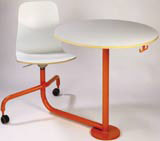Back to school for Design Council furniture scheme

School furniture has undergone what is claimed to be its most radical redesign for 50 years as the Government draws direct links between inspiring classroom environments and pupil attainment.
The Design Council and the Department for Education and Skills have collaborated with three design teams to create contemporary versions of the traditional school desk, workbench and primary school table. The work is unveiled tomorrow at a south London school.
Design Council director of learning and public services Hilary Cottam says the workplace has woken up to the link between staff morale and productivity and the design of the working environment and it’s time schools did, too.
‘In the past, some of our best designers, such as Robin Day, created furniture for schools. More funding to schools now means there’s an opportunity for designers to get involved with schools again.’
School standards minister David Miliband agrees there is a clear link between well-equipped schools and pupil performance. ‘Good furniture design is vital to ensure classrooms are inspiring places to work and learn,’ he says.
The teams of designers and manufacturers were awarded £20 000 each to create different products. Habitat furniture design head Matthew Hilton and designer Jorge Quarta have created a height-adjustable, stackable primary school table, manufactured by Remploy.
Design duo Azumi has reworked the traditional classroom chair and table with a swivel seat on wheels that orbits an adjustable round table. The piece by husband-and-wife team Shin and Tomoko Azumi, better known as product and furniture designers for companies such as Muji, is manufactured by Keen Group.
Independent designers William Warren and Carl Clerkin have created a design and technology workbench that aims to be more relevant to the way design is now taught in schools. The sturdy square bench, complete with stools, is manufactured by Emmerich (Berlon).
‘Traditional woodwork has been replaced in the curriculum by product design using materials such as plastics and card, so old-style work benches with vices in the way are out-of-date,’ says Warren, who visited schools as part of his research and saw ‘highly inappropriate’ furniture being used. ‘Our pieces are designed to empower teachers,’ he adds.
The problem in the past has been down to a limited choice of school furniture and even furniture that was exceptionally well made, Warren suggests. ‘Work benches in the past were so robust that they lasted a lifetime and were never replaced,’ he says.
Suggestions that schools won’t be able, or inclined, to buy into designer furniture were denied by the DfES. A spokeswoman says: ‘Recurrent funding allows schools to invest in resources that will raise standards. They use their funding to best support pupils’ learning.’
Cottam agrees that schools will invest in new furniture and says good design can also be cost-effective.
‘The products won’t necessarily cost more, and many schools have already ordered prototypes. We’re very confident [about their success],’ she says.
‘The project is not just about these three products. It’s part of our bigger Kit for Purpose initiative to educate schools in buying – we’re trying to transform the whole market,’ adds Cottam.
The scheme is part of the Design Council’s Furniture for the Future project, run in conjunction with the DfES, to bid for funding for new classroom furniture.
-
Post a comment



